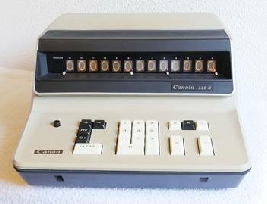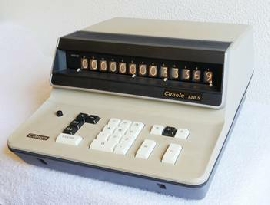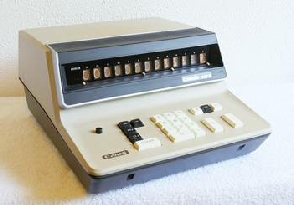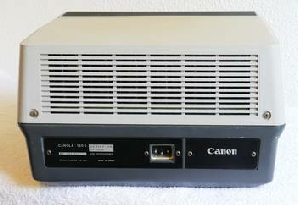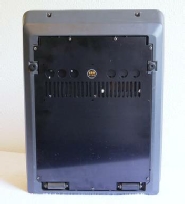






Details:
The 130s, by contemporary standards, may appear as a simple 13-digit calculator, performing basic arithmetic operations such as addition, subtraction, multiplication, and division. However, its significance becomes apparent when considering the technological landscape of the late 60s, where mechanical calculators demanded specialized knowledge for optimal use. The Canon 130s marked a pivotal shift by introducing several groundbreaking features:
- Elimination of Back Transfer: Unlike its predecessors, the 130s eradicated the need for back transfer, allowing seamless consecutive calculations, including divisions.
- Automatic Decimal Point Placement: Operators were relieved of the burden of manually placing the decimal point, as the 130s accomplished this task automatically.
- Improved Handling of Negative Numbers: Negative numbers were elegantly represented with a minus sign, replacing the cumbersome representation of a series of nines.
- Constant Operation in Multiplications and Divisions: The 130s enabled multiplications and divisions with constants, enhancing its versatility.
Beyond these remarkable features, the Canon 130s boasted remarkable speed and near-silent operation, with only a faint whisper from its small cooling fan. The result of a division with an accuracy of 8 digits is almost instantly available, while it takes 10 seconds on the Friden SBT10 which was still offered even at a significantly higher price than the Canon 310s. (source: BüromaschinenLexikon 1968/1969)
Despite its advancements, the 130s retained a power consumption level comparable to mechanical calculators, consuming 48W. Weighing just over 11 Kg, it didn't significantly lighten the load either.
The roots of the 130s trace back to the Canon 130, which according to Canon’s history was the world's first 10-key electronic calculator introduced in 1964. (See https://global.canon/en/corporate/history). In an era when semiconductors struggled with high voltages required for nixie tubes, the 130s innovatively employed light pipes. Each digit was represented by a transparent plastic sheet with small holes forming the digit. The sheets, illuminated from the side, displayed digits 0 to 9, with additional sheets for the decimal point and the green multiplication bar. The Canon 131s utilized 158 small 13V light bulbs to illuminate its 12 plastic sheets per display module. For photos see www.vintagecalculators.com.
The technological constraints of the time are evident in the 130s, housing 545 transistors and 868 diodes, a far cry from today's integrated circuits. Integrated circuits of the 7400-series, exemplified by the Philips P252, were only emerging in the late 60s.
The painstaking journey to bring the 130s to full functionality spanned eight years, numerous attempts, and countless hours, culminating in an operational triumph.
Usage:
Addition: Enter first number, press the black =-key, enter the second number, press the black =-key again, etc.
Subtraction: Like addition, but using the red =-key in stead.
Multiplication: Enter the first number, press the X-key, enter the second number, then press the black =-key
(or the red =-key for negative numbers)
When the A-switch is depressed, the total is kept taking positive as well as negative numbers into account.
Division: Like multiplication
Special keys:
- The ---> key shifts the numbers to the right. It is used to correct the input.
- The Cl-key clears the display.
- The Clear-key clears the machine and puts the decimal point to the right.
- The A-switch is pressed to keep a total of successive multiplications. The total is shown after each multiplication.
- The RV-key swaps dividend and divisor in a division
- The K-switch is used to multiply or divide using a constant. It is used as follows:
Multiplication: Enter first number A, X-key, second number B, K-key. A will be the constant. Now enter another B and the ‘=’-key.
Division: Enter first number A, :-key, second number B, K-key. B will be the constant. Now enter another A and the ‘=’-key.


Click to view a full size picture (opens in a new tab)

Serial number:
Built in:
Functions:
Power:
Market-introduction:
Production until:
Price:
861967
Probably approx. 1968/1969
Addition, Subtraction, Multiplication, Division
220V
1968
1969? (It appears one year only in Büromaschinen Lexikon)
DM 3700,- in 1968 (Source: Büromaschinen Lexikon)

| Mechanical Calculators |
| Electronic Calculators |
| Typewriters |
